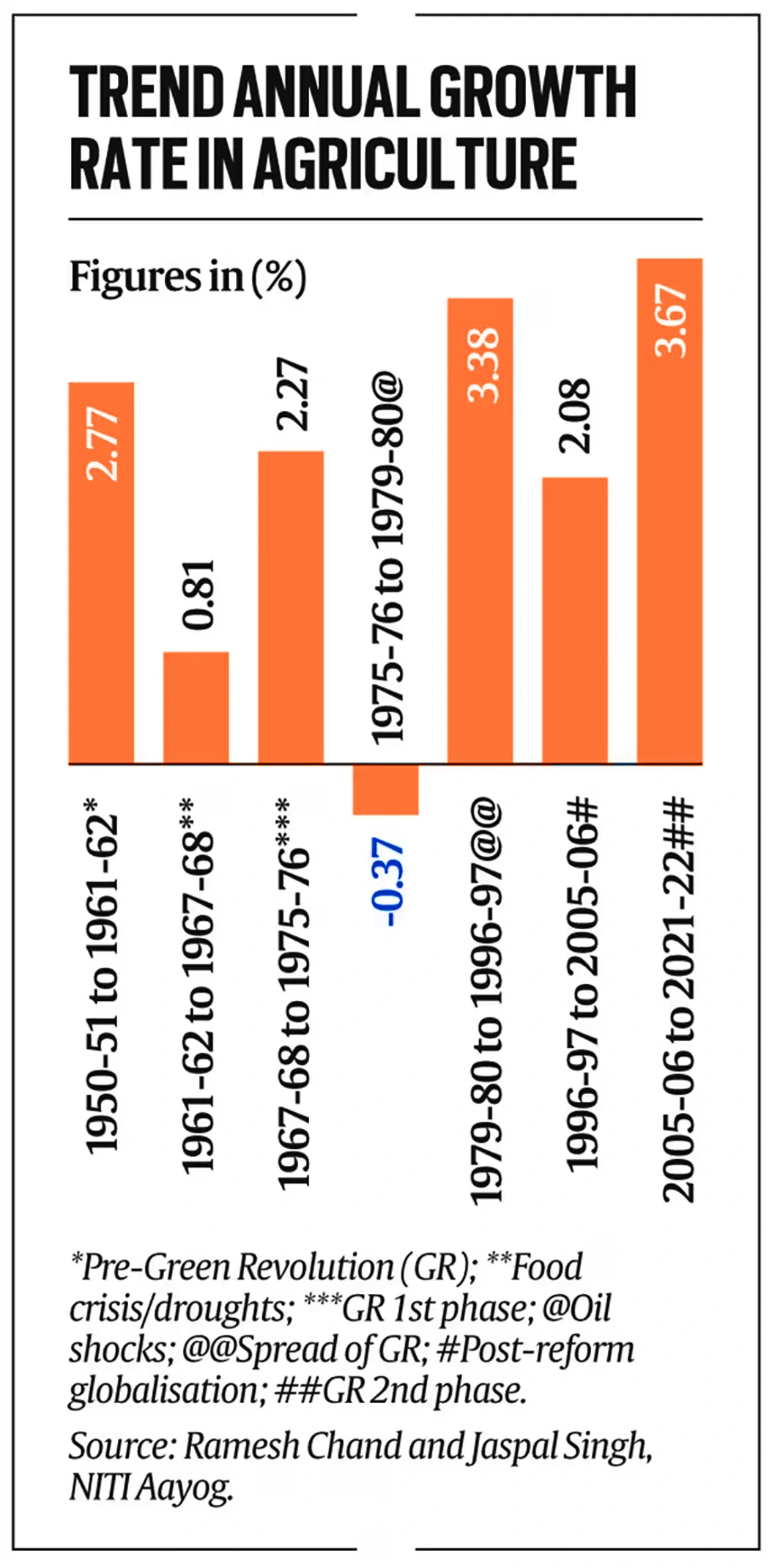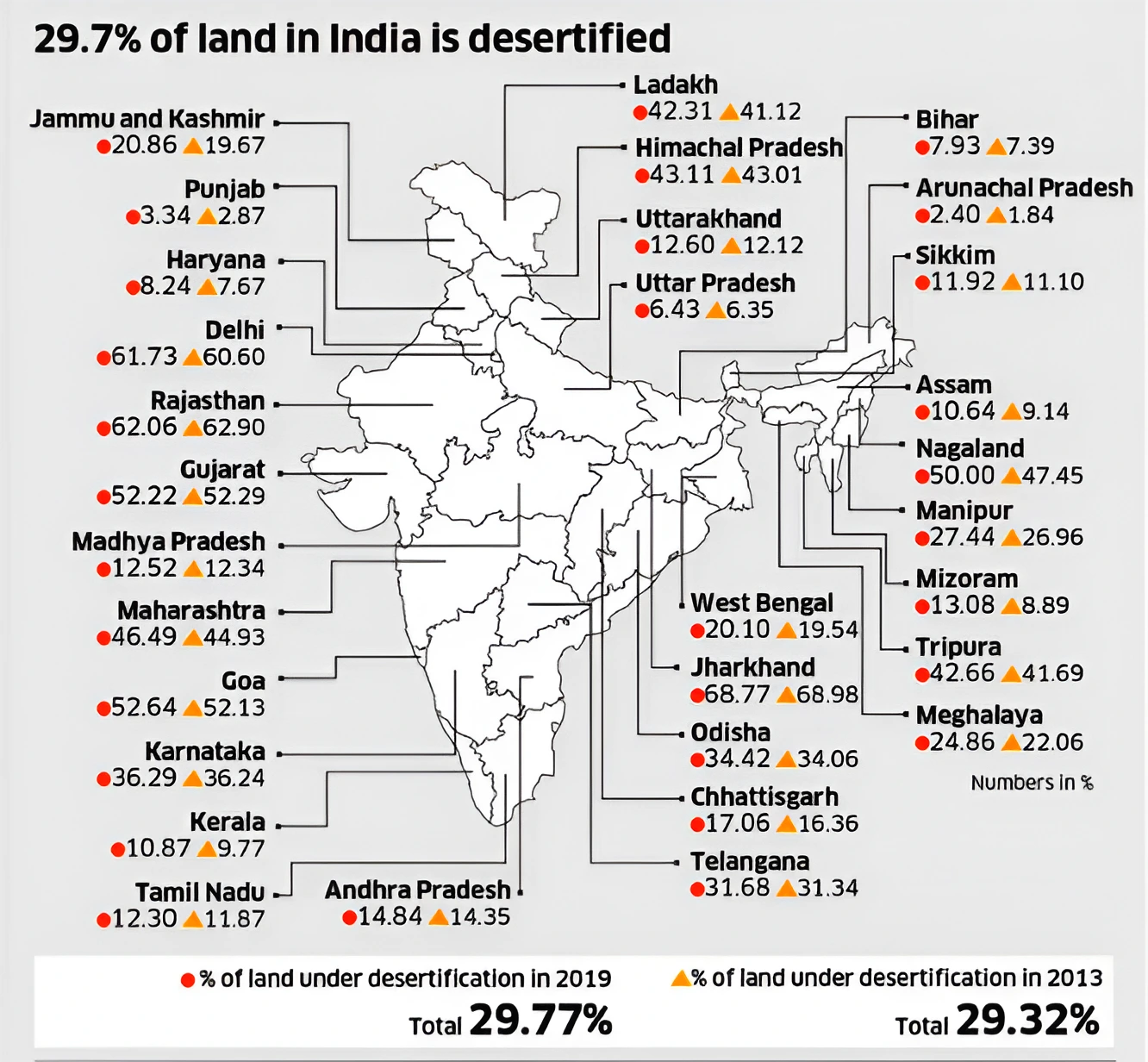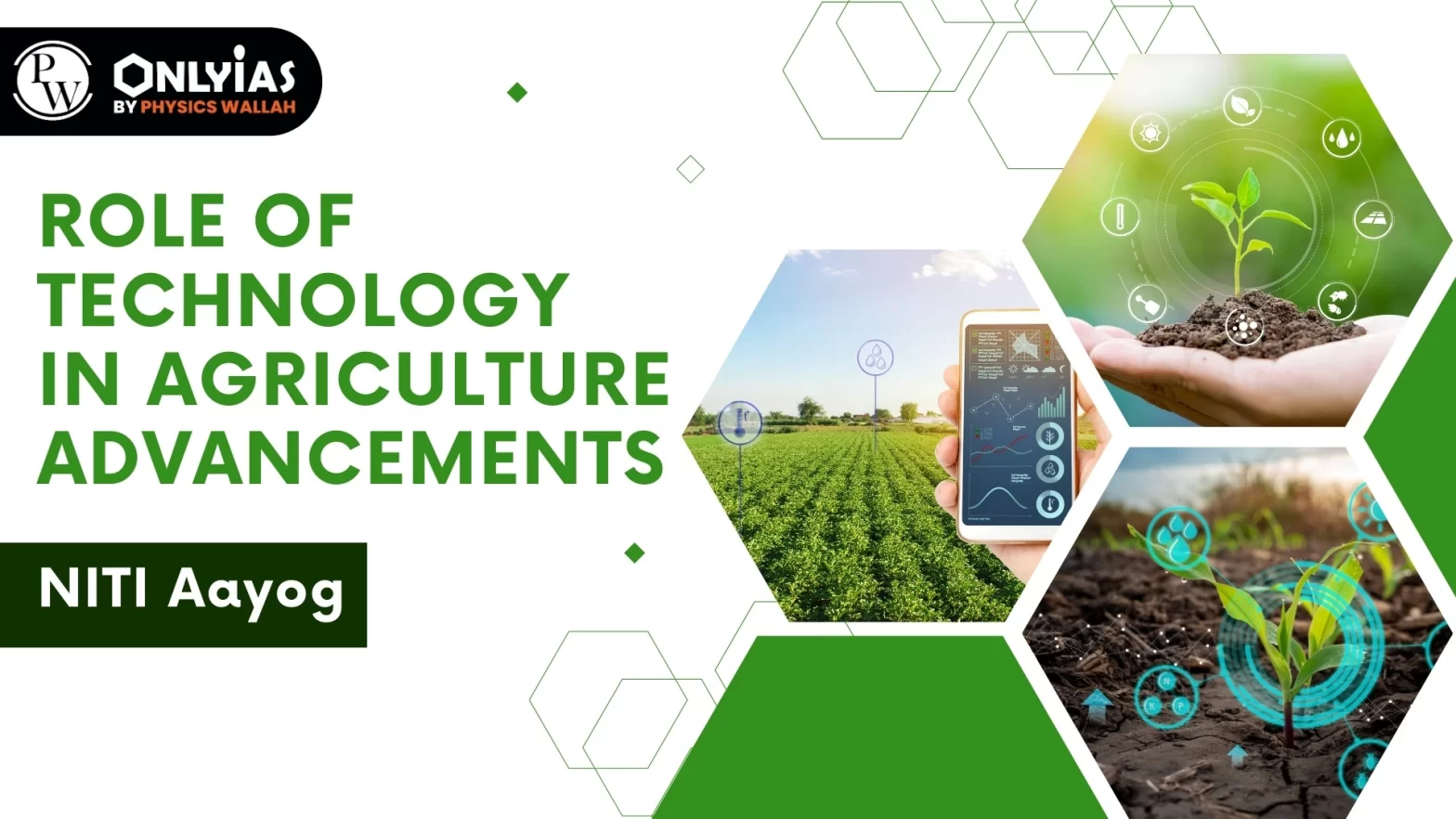Context: This article is based on the news “Producing more from less: How Indian agriculture has grown with limited ‘factors of production” Which was published in the Indian Express.
According to a NITI Aayog paper, despite limited Factors of Production, technology in agriculture, including factors such as genetics and agronomic interventions, has significantly boosted agricultural growth in India.
Technology in Agriculture – How Technology is Reshaping India’s Farming Practices?
- Agriculture Output is determined by the quantity of inputs used for a given level of technology in agriculture.
- Farmers use four “factors of production” Land, water, labor and energy to produce crops.
- Member (Agriculture) of NITI Aayog Ramesh Chand and consultant in the government think tank Jaspal Singh concluded in there studies that growth in agricultural production over the last 50 years or more has been mainly because of technological factors.
- This is evident from India’s net sown area rising by just 3.3% – from 135.4 lh to 139.9 lh – between 1961-62 and 2019-20, as against 14% from 1950-51 to 1961-62.
- The annual growth during the period from 2005-06 to 2021-22, at 3.7%, has been the highest among all phases (See Image).
Enroll now for UPSC Online Course

What are the key limitations in India’s agriculture sector?
Land:
- Land fragmentation: India’s average landholding size is just 1.08 hectares. This makes it difficult for farmers to use modern farming techniques and achieve economies of scale.
- The average size of operational holdings has decreased from 2.28 hectares in 1970-71 to 1.84 hectares in 1980-81, to 1.41 hectares in 1995-96, and to 1.08 hectares in 2015-16 as per the Agriculture Census (2015-16).
- Soil Degradation: Soil erosion, nutrient depletion, and salinization are all major problems in India. Overgrazing, deforestation, and the use of chemical fertilizers are major reasons (See Image).

Water:
- Water scarcity:
- India’s per capita water availability is just 1,500 cubic meters per year, compared to the global average of 5,000 cubic meters yearly.
- By 2050, it is projected that India will face a water deficit of 25%, making it one of the most water-stressed countries in the world.
- Lack of irrigation: As per the latest data against the total agricultural land of 1,80,888 thousand hectares, the cultivated land in the country is 1,53,888 thousand hectares. Of the total available agricultural land 71,554 thousand hectares or only 40 per cent is irrigated.
- Overexploitation of groundwater: In many parts of India, groundwater is being overexploited, leading to declining water levels and increased salinity.
- Over 60% of India’s groundwater is being overexploited. In many parts of India, groundwater levels have declined by up to 100 meters over the past few decades.
- Poor water management: Water infrastructure, such as canals and reservoirs, is often in disrepair. This leads to water losses and inefficiencies.
- Due to inefficient irrigation and distribution systems, India loses an estimated 25% of its water.
- A study by the World Bank found that India could save up to 50% of its water usage by improving irrigation infrastructure and management practices.
Energy:
- High energy costs: The energy cost for agriculture is high in India, due to factors such as subsidies and inefficient technologies.
- The accessibility, availability and high cost of electricity make it difficult for farmers to adopt modern farming techniques, such as drip irrigation, solar pumps and cold storage facilities.
Labor:
- Shortage of skilled labor: There is a shortage of skilled labor in India’s agriculture sector, due to factors such as migration to urban areas and a lack of training opportunities.
- The migration of young people from rural areas to urban centers has led to a shortage of skilled labor in agriculture.
- The low wages make it difficult for farmers to attract and retain workers, especially during peak seasons.
Also Read: Climate Smart Agriculture
How does technology contribute to India’s agricultural growth story?
- More Crop Per Acre, Per Farmland, And Per Drop Of Water: Technology enables more efficient use of production factors, resulting in higher yields.
- Farmers can produce from the same acre of land or number of laborers –besides better utilization of water resources and replacing animal and human power with mechanical and electrical power.
Enroll now for UPSC Online Classes
What are the four factors of technology in agriculture?
- Genetics: Development of the High-Yielding Varieties of wheat and rice were at the center of the Green Revolution.
- These varieties incorporated dwarfing genes that reduced the height of the plants, enabling them to absorb more nutrients and convert these to high yields.
- Crop Nutrition: The use of chemical fertilizers having much higher NPK content: Urea (46% N), di-ammonium phosphate (18% N and 46% P) and muriate of potash (60% K).
- Synthetic Fertilizers, combined with breeding varieties responsive to high nutrient doses, result in an increase in crop yields.
- Crop Protection Technologies: The application of pesticides, insecticides and herbicides helped to reduce crop yield from pathogens (fungi, bacteria, and viruses) and weeds.
- Crop protection chemicals ensured that the yield gains from genetics/breeding and nutrition/fertilizers would be realized in farmers’ fields to the maximum possible extent.
- For instance, herbicides helped to replace the manual removal of weeds.
- Farm Mechanization and other Agronomic interventions. Tractors have made it possible to use implements such as rotavators to do deep tillage, mix, and pulverize the soils and break their hardpan layers.
- Agronomic interventions also extend to water-saving technologies drip irrigation and laser land levelers (which help in the uniform placement of seed and fertilizer too) – and intercropping or growing more than one crop simultaneously on the same piece of land.
- Today, farmers cultivate pomegranates in Rajasthan’s arid desert soils through drip irrigation and water-soluble/liquid fertilizers.
What is the role of emerging technology in addressing India’s agricultural challenges?
- Generative AI: Generative AI can revolutionize Indian agriculture by providing farmers with real-time insights and recommendations based on vast amounts of data. This can help farmers:
- Optimize crop yields: Generative AI models can analyze soil conditions, weather patterns, and historical data to predict optimal planting dates, irrigation schedules, and fertilizer applications. This can help farmers to maximize crop yields while minimizing resource inputs.
Precision Agriculture:
- It is a data-driven approach to farm management that can improve productivity and yields, thereby increasing the overall profitability of farming.
- It helps reduce the need for inputs such as water, artificial fertilizers and pesticides, thus reducing the environmental footprint of farming.
- It includes using mobile phones, remote sensing using satellites, unmanned aerial vehicles (UAVs), Internet of Things (IoT), artificial intelligence (AI), and cloud computing, etc.
|
- Improve crop quality: Generative AI can identify genetic traits associated with desirable crop characteristics, such as improved yield, disease resistance, and drought tolerance. This can help breeders develop new crop varieties better suited to local conditions.
Geo-Spatial Technology: Geo-spatial technology such as remote sensing can map soil conditions, crop health, and water resources. This information can then be used to develop precision agriculture plans to help farmers:
- Target fertilizer and pesticide applications: Geo-spatial maps can show farmers where their crops are most deficient in nutrients or where pests and diseases are most prevalent. This allows farmers to target their inputs more precisely, which can reduce waste and improve the environment.
- Monitor crop health: Geo-spatial imagery can be used to track crop health over time. This allows farmers to identify problems early on, such as nutrient deficiencies or disease outbreaks, and take corrective action.
Drones: Drones can be used for various tasks in agriculture, including
- Spraying. Drones can use sprayers to apply pesticides, herbicides, and fertilizers. This can be done more precisely and efficiently than traditional methods, such as using tractors or helicopters.
Sensors and Microchips: Sensors can be used to collect real-time data on crop health, soil conditions, and environmental factors. This data can then be used to:
- Monitor crop growth: Sensors can be used to measure factors such as plant height, leaf area, and chlorophyll levels. This information can be used to track crop growth and identify any problems that may be affecting yield.
- Optimize irrigation: Sensors can be used to measure soil moisture levels and evapotranspiration rates. This information can then be used to develop precise irrigation schedules.
- Reduce pesticide use: Sensors can be used to identify pest and disease outbreaks early on, allowing farmers to take targeted interventions instead of blanket spraying pesticides. This can reduce the environmental impact of agriculture and improve food safety.
Enroll now for UPSC Online Course
What challenges are associated with using technology in Agriculture?
- Lack of Awareness and Understanding: Smallholder farmers often lack awareness and understanding of the benefits and applications of modern agricultural technologies. This knowledge gap hinders their ability to adopt and utilize these technologies effectively.
- A survey by the National Bank for Agriculture and Rural Development (NABARD) revealed that 60% of farmers lack the technical knowledge to adopt modern agricultural practices.
- Lack of Capital: Adopting modern agricultural technologies often requires significant upfront investments in equipment, machinery, sensors, and data analytics tools. This poses a major challenge for smallholder farmers with limited financial resources.
- The average cost of adopting precision agriculture technologies in India is estimated to be around ₹50,000 per acre.
- The Agricultural Census 2015-16 classifies about 86 percent of farmers as small and marginal, having less than one hectare of land and relatively lower income than their consumption expenditure.
- Labor Disruption: Implementing automation technologies, such as automated harvesting machines and robotics, can lead to job displacement and social disruption in rural areas.
- The adoption of labor-saving technologies in agriculture is expected to displace an estimated 30% of agricultural laborers in India by 2030.
- Regional Disparity and Inequalities: The adoption of modern agricultural technologies is often uneven across different regions of India, with farmers in more developed regions having greater access to technology and financial resources. This can exacerbate existing regional disparities and inequalities.
- A study by the Indian Institute of Technology Delhi found a significant gap in the adoption of precision agriculture technologies between different states in India.
- Lack of Training and Localized Assistance: This can hinder the effective implementation of these technologies at the farm level.
- A survey by the Indian Council of Agricultural Research (ICAR) revealed that only 40% of farmers have received training on the use of modern agricultural technologies.
Government Initiatives:
- YES-TECH is a technology-driven yield estimation system offering methodologies, best practices, and integration insights for accurate yield assessments at the Gram Panchayat level.
- WINDS Portal is a centralized platform that hosts, manages, and processes hyper-local weather data collected by Automatic Weather Stations and Rain Gauges at Taluk/Block and Gram Panchayat levels.
- The portal enhances risk assessment and decision-making in crop insurance, agriculture advisories, and disaster mitigation, supporting the agricultural sector and rural economy.
- The AIDE app aims to revolutionize enrolment, bringing it directly to farmers’ doorstep. This door-to-door enrolment ensures a seamless and transparent process, making crop insurance more accessible and convenient for farmers.
- The Indian Council of Agriculture Research (ICAR) has also compiled over 100 mobile apps developed by ICAR, State Agricultural Universities and Krishi Vigyan Kendras and uploaded them on its website.
- Kisan Sarathi: a Digital multimedia platform named as which is being used to provide advisories to the farmers through 731 KVKs across the Country.
- Sensor-based Smart Agriculture (SENSAGRI): In this project, drones are used to collect precious information and transfer the data to farmers in real-time.
- e-Crop (electronic crop): It is an IoT device by Central Tuber Crops Research Institute (CTCRI) for providing crop-specific agro advisories to farmers through text messages.
|
- Environmental Concerns: The intensive use of chemical fertilizers and pesticides, can have negative environmental impacts, such as soil degradation, water pollution, and biodiversity loss.
- The use of pesticides has been linked to water pollution and the decline of pollinators, such as bees, which are essential for crop pollination.
Way Forward:
- Awareness creation among farmers: There is a need for awareness among farmers and other stakeholders about the impact of climate change and the need for undertaking mitigation and adaptation activities, which can be incentivised through the Green credit scheme.
- Green Credit Scheme is an innovative market-based mechanism incentivizing voluntary environmental actions across diverse sectors.
- Solarization of Agriculture: As per Ministry of New and Renewable Energy the adoption of solar-powered irrigation help reduce the burden of over Rs 1 lakh crore towards agriculture’s electricity subsidy and reduce oil import bill by reducing diesel consumption by 1.38 billion liters per annum.
-
- Furthermore, it is estimated that off-grid solarisation of pumps can help reduce transmission & distribution losses by up to 20%, according to the World Irrigation Forum report.
- Strengthening Training and Extension services: A strong agricultural extension system is vital in transferring the knowledge and technology generated by the research system to the diverse categories of stakeholders that may lead to its adoption, and further, to translate production gains into increased value generation.
- Restructuring of the Indian agricultural extension system is vital in developing the sector into a major source of growth in the Indian economy.
- Cooperative Farming: It was, therefore, necessary to make cost-effective usage of new technology on small and marginal-size holdings through some institution-building measures like the formation of group farming.
- Promoting Sustainable Agricultural Practices: Encouraging the adoption of sustainable technologies and practices, such as organic farming, precision agriculture, and conservation agriculture, to minimize environmental impacts.
- Green Revolution to Gene Revolution: GM seeds are considered to be more productive, more pest-resistant and more suitable to all categories of farms and all the agricultural regions.
- However, the adoption of gene technology in Indian agriculture is subject to debate and discussion, as its positive and negative effects on plants, animals and human lives have not yet been fully examined.
Conclusion:
Emerging Technologies have the potential to transform the agriculture sector towards low-input, high-efficiency and sustainable to increase agricultural productivity, improve farmer livelihoods, and ensure food security and achieve the Sustainable Development Goals (SDG indicator 2.4.1).
Enroll now for UPSC Online Classes
| Prelims Question (2017)
Which of the following statements can help in water conservation in agriculture?
1. Reduced or zero tillage of the land
2. Applying gypsum before irrigating the field
3. Allowing crop residue to remain in the field
Select the correct answer using the code given below:
(a) 1 and 2 only
(b) 3 only
(c) 1 and 3 only
(d) 1, 2 and 3
Ans: (c) |



